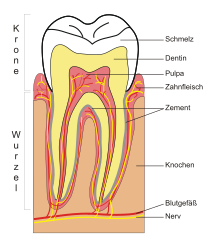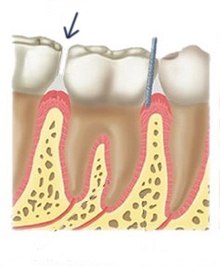Approximal enamel reduction
The interproximal enamel reduction (ASR) is a method of orthodontics to be treated by the crowding of teeth. With ASR, the tooth enamel is reduced by (a few) tenths of a millimeter according to individual needs, so that tooth extraction can be dispensed with. In the English-speaking world, the terms interproximal reduction or air rotor stripping are used for this method .
Limits
The enamel reduction may only be carried out within narrow limits, as otherwise the susceptibility to caries in the interdental space (interdental space) is increased. The limit is 50% of the enamel thickness. This results in a maximum gain of 10 mm in space in a jaw. The individual tooth shape and the different ethnicities, which can result in less space gain, must be taken into account. On the anterior teeth, a reduction of around 0.75 mm per interdental space is the upper limit, and a reduction of 1 mm on the posterior teeth.
history
As early as 1944, Murray Ballard presented the removal of tooth enamel in the journal The Angle Orthodontist . Then, in 1956, a study by Arthur Hudson was published in the American Journal of Orthodontics , examining the effects of tooth enamel reduction. The method aroused worldwide interest in the 1980s after J. Sheridan described ASR as an alternative to molar extraction in two highly regarded articles.
literature
- Nezar Watted: The approximal enamel reduction . zwp-online.info, March 16, 2011.
- C. Livas, AC Jongsma, Y. Ren: Enamel reduction techniques in orthodontics: a literature review. In: The open dentistry journal. Volume 7, 2013, pp. 146–151. doi: 10.2174 / 1874210601307010146
Individual evidence
- ↑ C. Livas, AC Jongsma, Y. Ren: Enamel reduction techniques in orthodontics: a literature review. In: The open dentistry journal. Volume 7, 2013, pp. 146–151. doi: 10.2174 / 1874210601307010146

